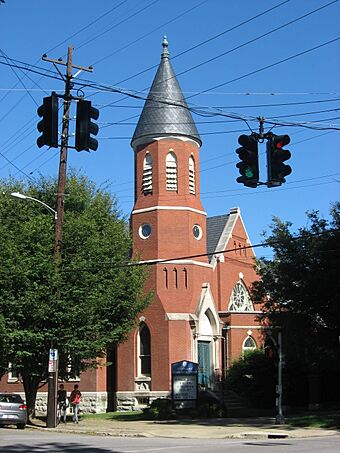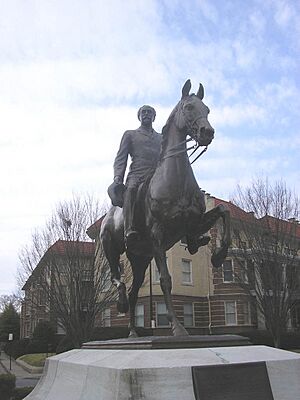Cherokee Triangle, Louisville facts for kids
Quick facts for kids |
|
|
Cherokee Triangle Area Residential District
|
|

Highland Presbyterian Church, built in 1888, is a fixture in the Cherokee Triangle neighborhood.
|
|
| Lua error in Module:Location_map at line 420: attempt to index field 'wikibase' (a nil value). | |
| Location | Roughly bounded by Bardstown Rd., Sherwood Rd., Broadway, E to jct. of Grinstead Dr. and Cherokee Pkwy., Louisville, Kentucky |
|---|---|
| Area | 500 acres (200 ha) |
| Built | 1882 |
| Architect | Multiple |
| Architectural style | Late 19th And 20th Century Revivals, Late 19th And Early 20th Century American Movements, Late Victorian |
| NRHP reference No. | 76000902 |
| Added to NRHP | June 30, 1976 |
The Cherokee Triangle is a special old neighborhood in Louisville, Kentucky, USA. It is known for its large, beautiful homes. These homes show off many different building styles. The neighborhood is bordered by Bardstown Road to the southwest. Cherokee Park and Eastern Parkway are to the southeast. Cave Hill Cemetery is to the north. It is part of a bigger area in Louisville called The Highlands. The neighborhood gets its name from Cherokee Park, which is nearby. This park is 409 acres (1.66 km2) big. It was designed by Frederick Law Olmsted. He also designed New York's famous Central Park.
Contents
A Look Back: History of Cherokee Triangle
The land where Cherokee Triangle now sits was once a huge military land grant. This grant was for 6,000 acres (24 km2) in 1774. Over the years, many different people owned the land. In 1863, George Douglass bought most of the land. His home was located where Dearing Court and Dudley Avenue meet. This spot is now part of the Cave Hill Cemetery.
How the Neighborhood Grew
In 1869, George Douglass sold 125 acres (0.51 km2) of land. He sold it to two real estate developers, James W. Henning and Josiah S. Speed. They paid $135,000 for the land. Henning and Speed had big plans for this area. They wanted to create a wonderful place for suburban living. They even planned to build their own homes there.
The biggest part of Cherokee Triangle was developed in the 1880s. It became an early streetcar suburb of Louisville. This means people could easily travel to the city center by streetcar. In 1870, they created the first section, called the Highland Addition. It had 150 lots, each about 60 by 180 feet. The very first house in the neighborhood was finished in 1871. It was a wedding gift for Henning's daughter.
Early Challenges and Growth
Henning and Speed sold lots quickly between 1870 and 1873. Each lot sold for about $1,200. But then, an economic downturn happened in 1873. This was called the Panic of 1873. Building new homes almost stopped in Cherokee Triangle and other places.
Development was slow until 1883. That year, Louisville hosted the Southern Exposition. This big event helped the real estate market. It especially boosted areas like the Highlands. In 1884, Clayton Longest also divided his property into lots. Still, prices for land were quite low.
In 1891, Cherokee Park opened nearby. This made the area very popular. Wealthy families wanted to build their homes there. Soon, all the undeveloped land was built up. This included the Baringer Farms subdivision.
Becoming Part of Louisville
Much of Cherokee Triangle was once part of a small city called Enterprise. This city was formed in 1884. It was created to help with taxes. It also helped keep alcohol sales out of the community. Enterprise even had its own school, which is now Bloom Elementary. In 1896, Enterprise officially became part of Louisville. This process is called annexation.
Protecting the Neighborhood's Charm
After World War II, many wealthy residents moved to newer suburbs. Like other old, rich neighborhoods, many large homes were divided into smaller, cheaper apartments. To stop this trend, the Cherokee Triangle Association was formed in 1962. They created new rules. They also changed zoning laws to protect the area.
In 1975, Cherokee Triangle was named a "preservation district." This meant there were rules to keep its unique look. For example, it stopped new, modern apartment buildings from being built. These buildings were seen as not fitting in. Because of this special status, the neighborhood has become very popular again. Property values have increased a lot in recent years.
One example of a building that didn't fit was the Aquarius Apartments. Its construction helped lead to the creation of the preservation district. Recently, a developer bought these apartments. He wanted to tear them down and build a luxury condo building. His plan was rejected because it was too big. But it shows how much people want to live in this neighborhood now.
Fun Events and Landmarks
The neighborhood is famous for its yearly art fair. This fair happens over a weekend in late April. It's one week before the famous Kentucky Derby.
A well-known landmark was a statue of General John Breckinridge Castleman. It was put up in 1913. People used to say it was the only horse statue in the world where the real horse also posed! The statue was removed on June 8, 2020.
Images for kids



